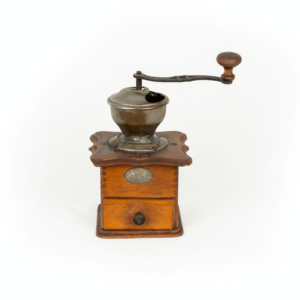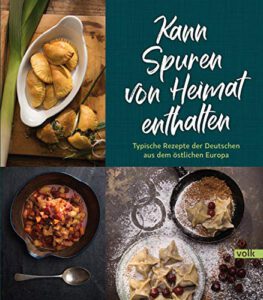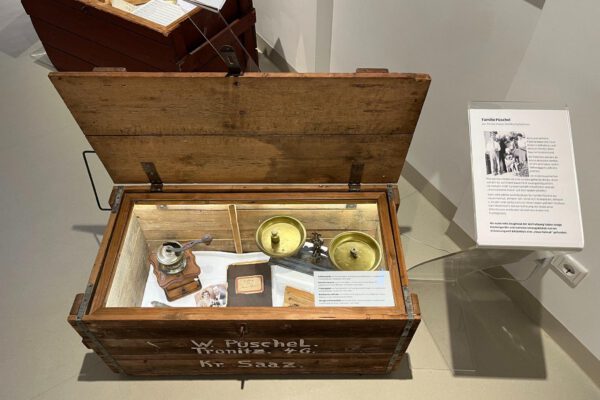An exhibition about food and drink, identity and integration of the Germans from Eastern Europe
Years of hunger and abundance, family recipes, the reestablishment of companies and the production of old familiar products, identity preservation and integration – all this determined everyday life for many Germans from Eastern Europe, whether they came to Germany after 1945 as refugees and expellees, or in the course of the following decades as repatriates and ethnic German immigrants.
Whether Bohemian Knödel, Königsberger Klopse, Karlsbad Oblaten, Liegnitzer Bomben, sweets with Streusel or poppy seeds from Silesia, or the famous Schlesische Himmelreich – many people from eastern Europe associate a piece of home with such dishes.

The history of the Germans from Eastern Europe goes back more than 800 years. Their settlements stretched from the Baltic States in the north all the way to southeastern Europe. The diversity of landscapes, climate, soils, forests, seas, lakes and rivers, but also the ownership of land, had a decisive influence on the agricultural products and the resulting diets of the population. But also light or heavy physical labor, belonging to a certain social class, wealth or poverty determined the daily menu. Over the centuries, the German inhabitants in each country and region developed their own recipes for food and drink. In many places, culinary boundaries could and can no longer be clearly drawn. The mutual influence in the kitchen can be felt in the stories, and recipe books.
How much of this culinary diversity, as well of products and companies, found its way into post-war Germany after flight and expulsion? What is bought, eaten, or used in our country today without any thought given to its origin or original places of production? How much has the respective culinary heritage contributed to the preservation of the identity of Germans from the Baltic States, East Prussia, Pomerania, Russia, Silesia, Bohemia, Moravia, Slovakia, Hungary, Yugoslavia or Romania? How did kitchen traditions brought with them and newly established production facilities facilitate their integration into West German society?

Exhibit cookbook May contain traces of home
The special exhibition “May Contain Traces of Home” from the Haus des Deutschen Ostens (House of the German East) in Munich explores these questions. It deals with the broad topic of food and drink, everyday life, identity and integration. It explores the reality of life for refugees after 1945 as well as for ethnic German repatriates in later years. The exhibition takes a look at the hunger years in the post-war period as well as at the affluent Western society that the later repatriates initially encountered. Many of the companies still known today in the food and luxury food industry were founded by Germans from Eastern Europe. As a result, these companies played a significant role in Germany’s economic reconstruction after the Second World War and beyond. A closer look at the shelves of supermarkets shows that many “eastern German traces” can still be found in German stores today. Family recipes, typical dishes, homemade furniture, kitchen utensils brought along and much more are presented.
In the BADEHAUS Place of Remembrance, the exhibition is supplemented by objects, family biographies and interviews with contemporary witnesses from back when the expellees first settled Waldram. It was officially opened on November 6, 2022, as part of a ceremony celebrating “65 years” of Waldram.
Cookbook

Pilav, Piroggen, mushroom soup, the Schlesische Himmelreich or the ever-popular Königsberger Klopse, Streuselkuchen or Harlekinschnitten – for the first time, the wide range of culinary diversity of the Germans of Eastern Europe is united in one cookbook. These typical recipes come from the Baltic States, from East Prussia, Pomerania, Silesia, Bohemia and Moravia, from Slovakia, Bukovina, from the Russian Germans, Danube Swabians and Transylvanian Saxons; recipes, which for many mean an irreplaceable memory of their family’s former homeland. The recipes are delightfully photographed and tempt the reader to try them out again. Perhaps there are even traces of your homeland among them…
The cookbook is available for 24,90€ at the cash desk.
Further details can be found in the linked press articles under the tab “Details”, photographic impressions under the tab “Gallery”.
Funded by:

Text source: Haus Schlesien, Königswinter. Photos: A coffee grinder and a cookbook from Waldram. Copyright: Justine Bittner, Jonathan Coenen.





